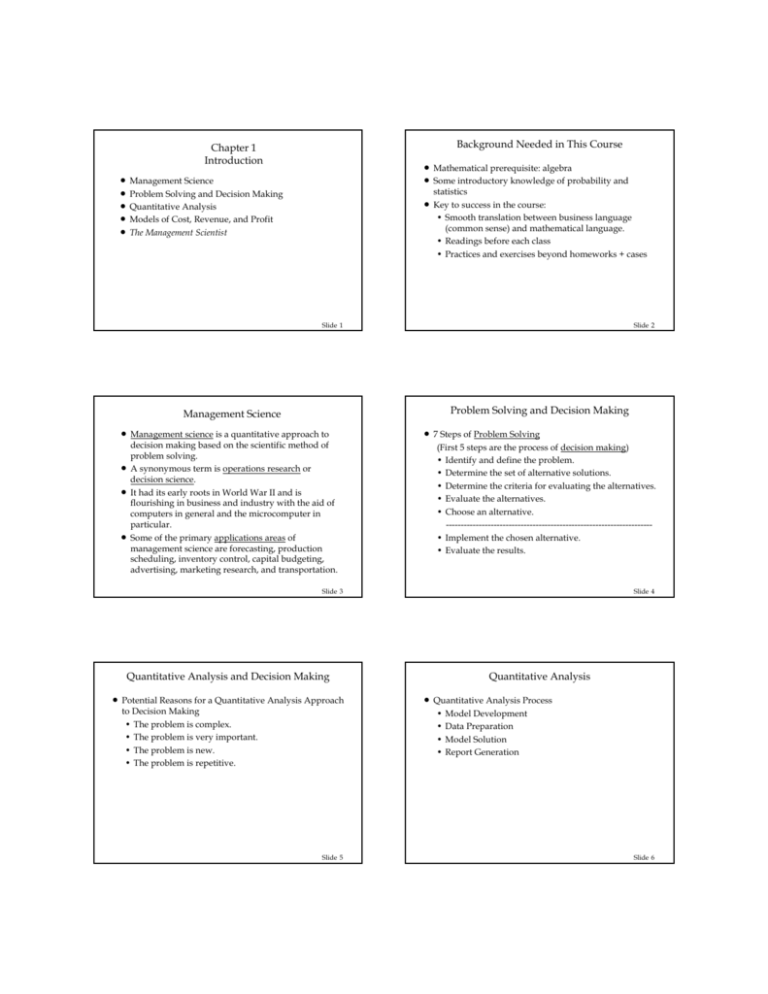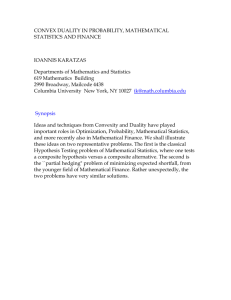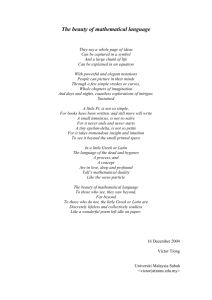Chapter 1 Introduction Background Needed in This Course
advertisement

Background Needed in This Course Chapter 1 Introduction n Management Science Problem Solving and Decision Making Quantitative Analysis Models of Cost, Revenue, and Profit The Management Scientist n n n n n n n Mathematical prerequisite: algebra Some introductory knowledge of probability and statistics Key to success in the course: • Smooth translation between business language (common sense) and mathematical language. • Readings before each class • Practices and exercises beyond homeworks + cases Slide 1 Slide 2 Problem Solving and Decision Making Management Science n n n n Management science is a quantitative approach to decision making based on the scientific method of problem solving. A synonymous term is operations research or decision science. It had its early roots in World War II and is flourishing in business and industry with the aid of computers in general and the microcomputer in particular. Some of the primary applications areas of management science are forecasting, production scheduling, inventory control, capital budgeting, advertising, marketing research, and transportation. n 7 Steps of Problem Solving (First 5 steps are the process of decision making) • Identify and define the problem. • Determine the set of alternative solutions. • Determine the criteria for evaluating the alternatives. • Evaluate the alternatives. • Choose an alternative. --------------------------------------------------------------------• Implement the chosen alternative. • Evaluate the results. Slide 3 Slide 4 Quantitative Analysis and Decision Making n Potential Reasons for a Quantitative Analysis Approach to Decision Making • The problem is complex. • The problem is very important. • The problem is new. • The problem is repetitive. Slide 5 Quantitative Analysis n Quantitative Analysis Process • Model Development • Data Preparation • Model Solution • Report Generation Slide 6 Model Development n n Mathematical Models Models are representations of real objects or situations. Three forms of models are iconic, analog, and mathematical. • Iconic models are physical replicas (scalar representations) of real objects. • Analog models are physical in form, but do not physically resemble the object being modeled. • Mathematical models represent real world problems through a system of mathematical formulas and expressions based on key assumptions, estimates, or statistical analyses. n n n Cost/benefit considerations must be made in selecting an appropriate mathematical model. Frequently a less complicated (and perhaps less precise) model is more appropriate than a more complex and accurate one due to cost and ease of solution considerations. The purpose, or value, of any model is that it enables us to make inferences about the real situation by studying and analyzing the model. • more efficient; less time required. • less expensive. Slide 7 Slide 8 Mathematical Models n n n n n Example: Iron Works, Inc. Mathematical models relate decision variables (or controllable inputs) with fixed or variable parameters (or uncontrollable inputs). Frequently mathematical models seek to maximize or minimize some objective function subject to constraints. If any of the uncontrollable inputs is subject to variation the model is said to be stochastic; otherwise the model is said to be deterministic. Generally, stochastic models are more difficult to analyze. The values of the decision variables that provide the mathematically-best output are referred to as the optimal solution for the model. Iron Works, Inc. (IWI) manufactures two products made from steel and just received this month's allocation of b pounds of steel. It takes a1 pounds of steel to make a unit of product 1 and it takes a2 pounds of steel to make a unit of product 2. Let x1 and x2 denote this month's production level of product 1 and product 2, respectively. Denote by p1 and p2 the unit profits for products 1 and 2, respectively. The manufacturer has a contract calling for at least m units of product 1 this month. The firm's facilities are such that at most u units of product 2 may be produced monthly. Slide 9 Slide 10 Example: Iron Works, Inc. n Example: Iron Works, Inc. Mathematical Model • The total monthly profit = (profit per unit of product 1) x (monthly production of product 1) + (profit per unit of product 2) x (monthly production of product 2) = p1x1 + p2x2 We want to maximize total monthly profit: Max p1x1 + p2x2 n Slide 11 Mathematical Model (continued) • The total amount of steel used during monthly production = (steel required per unit of product 1) x (monthly production of product 1) + (steel required per unit of product 2) x (monthly production of product 2) = a1x1 + a2x2 This quantity must be less than or equal to the allocated b pounds of steel: a1x1 + a2x2 < b Slide 12 Example: Iron Works, Inc. n Example: Iron Works, Inc. Mathematical Model (continued) • The monthly production level of product 1 must be greater than or equal to m: x1 > m • The monthly production level of product 2 must be less than or equal to u: x2 < u • However, the production level for product 2 cannot be negative: x2 > 0 n Mathematical Model Summary Max p1x1 + p2x2 s.t. a1x1 + a2x2 < > x1 x2 < x2 > b m u 0 Slide 13 Slide 14 Example: Iron Works, Inc. n n Example: Iron Works, Inc. Question: Suppose b = 2000, a1 = 2, a2 = 3, m = 60, u = 720, p1 = 100, p2 = 200. Rewrite the model with these specific values for the uncontrollable inputs. Answer: Substituting, the model is: Max 100x1 + 200x2 s.t. 2x1 + 3x2 < 2000 > 60 x1 x2 < 720 0 x2 > n n Question: The optimal solution to the current model is x1 = 60 and x2 = 626 2/3 [after using the Management Scientist]. If the product were engines, explain why this is not a true optimal solution for the "real-life" problem. Answer: One cannot produce and sell 2/3 of an engine. Thus the problem is further restricted by the fact that both x1 and x2 must be integers. They could remain fractions if it is assumed these fractions are work in progress to be completed the next month. Slide 15 Slide 16 The Management Scientist n The Management Scientist Major Elements • Top Level Menu • Problem Selection Menu • Data Input • Problem Disposition Menu • Solution and Output Information • Data Editing • Saving, Retrieving, and/or Deleting Problems n 1 2 3 4 5 6 Slide 17 Top Level Menu THE MANAGEMENT SCIENTIST Top Level Menu Linear Programming 7 PERT/CPM Transportation 8 Inventory Models Assignment 9 Waiting Lines Integer Linear Programming 10 Decision Analysis Shortest Route 11 Forecasting Minimal Spanning Tree 12 Markov Processes 13 EXIT PROGRAM Slide 18 The Management Scientist n The Management Scientist Problem Selection Menu n PROBLEM SELECTION MENU Choices 1 Create a New Problem 2 Retrieve a Previously Saved Problem 3 Continue with the Current Problem 4 Delete a Previously Saved Problem 5 Return to the Top Level Menu Problem Disposition Menu PROBLEM DISPOSITION MENU Choices 1 Solve the Problem 2 Save the Problem 3 Display/Edit the Problem 4 Return to the Problem Selection Menu Slide 19 Breakeven Analysis Slide 20 The End of Chapter 1 Fixed costs (cf) - costs that remain constant regardless of number of units produced Variable cost (cv) - unit cost of product Total variable cost (v cv) - function of volume (v) and variable per-unit cost Total cost (TC) - total fixed cost plus total variable cost Profit(Z) - difference between total revenue vp (p=price) and total cost: Z = v p - cf – v cv The break-even point is that volume at which total revenue equals total cost and profit is zero: V = cf/(p-cv) Slide 21 Slide 22 Self Quiz n n Self Quiz Algebra Basics: Solve for x1 and x2 in the following equations 4x1 - x2 = 12 x1+ x2 = 4 Statistics Basics: Suppose z is a standard normal variable (with mean 0 and standard deviation of 1). • What is the probability that z is less than z0=1? • What is the probability that z is greater than z0=1? Slide 23 The price of a particular stock listed in NYSE is fluctuating up and down from one transaction to the next according to the following probability distribution. Price Change Probability -3/8 .08 -1/4 .04 -1/8 .16 0 .40 +1/8 .20 +1/4 .06 +3/8 .04 +1/2 .02 TOTAL 1.00 Q: What is the cumulative probability that the price change is less than and equal to +1/4? Q: What is the expected amount of price change (per transaction)? Slide 24








